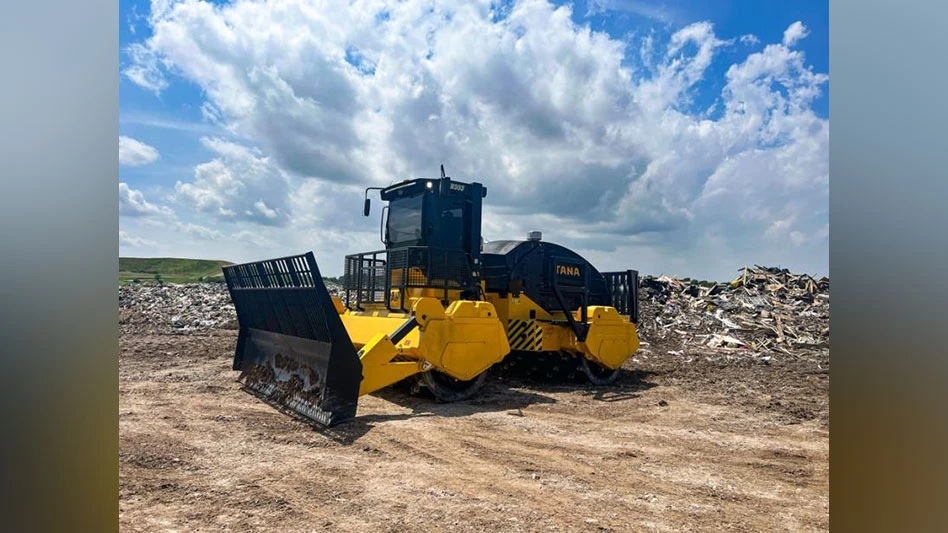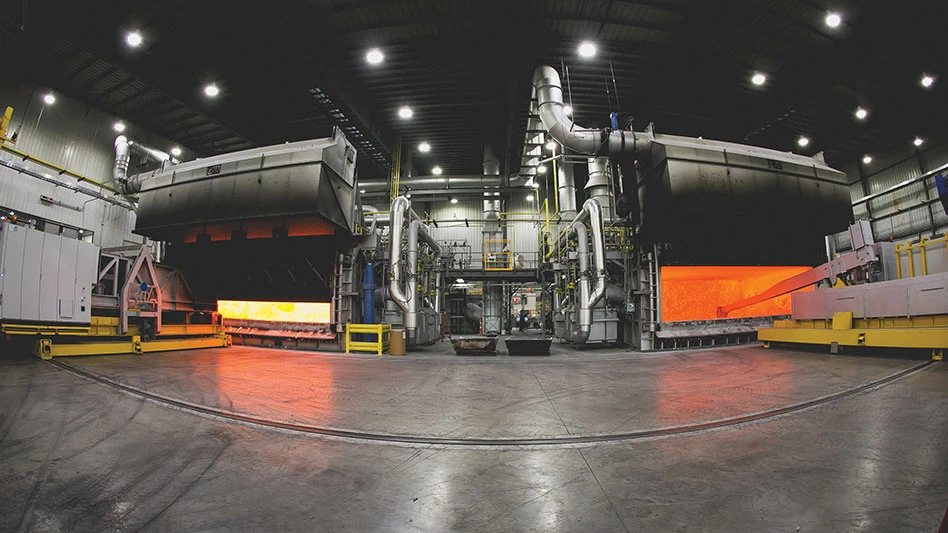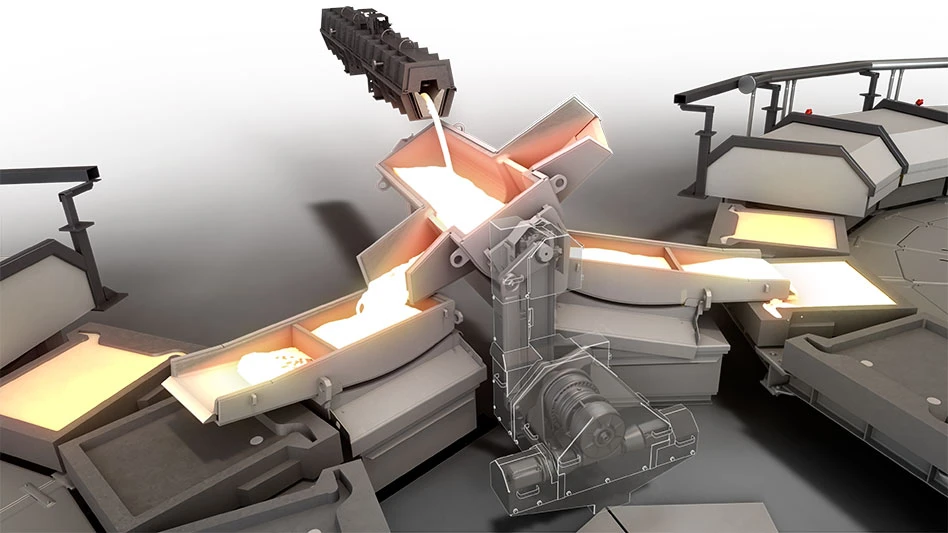Scrap handlers perform tough tasks in harsh environments, and that makes planned maintenance even more critical. The last thing a scrap recycler needs is to have a scrap handler go down because someone forgot to conduct a routine maintenance check, or worse yet, because of a pattern of neglect.
In many ways, scrap handlers with their diesel engines, require standard maintenance like most heavy-duty machines in their class, such as routine oil analysis and filtering, coolant monitoring and flushing, and daily visual and lubrication checks. Of course, the maintenance routines of electric-driven stationary handlers differ. But mobile scrap handlers and their electric cousins also need maintenance attention in other areas as well. These include the attachments and hydraulic system, but tracked handlers need undercarriage care, as well.
KEEP FLUIDS CLEAN
As with any machine, proper oil care is always a crucial part of a good maintenance program. This is especially true when equipment such as scrap handlers operate in a harsh environment.
A good oil analysis program will keep profits in the scrap recycler's pocket, and keep the company's material handlers running at peak efficiency. ¡°Too often we see oil that should have been changed months ago, or oil that could have been left in the engine for another six months,¡± says one maintenance engineer for a major equipment manufacturer. ¡°It could mean the difference between blowing an engine or blowing money out the window. You want good oil analysis so that neither happens.¡±
Most oil analysis is performed with a spectrometer that detects micron particles. By analyzing the different elements in the oil, such as lead, iron, copper, silicon, sodium, etc., the maintenance person can pinpoint the problem area. For instance, a high level of silicon normally means that dirt is getting into the engine somehow; the presence of sodium usually indicates water or engine coolant is leaking into the oil system; and the presence of too much metal in the oil points to excessive wear within the engine, transmission or drive system.
It is important to analyze the oil on a regular schedule, and not just do it once in a while. Through periodic analysis, maintenance personnel can spot trends and track the ones that will most likely lead to some sort of system failure.
Another analysis involves particle counts as per the International Standards Organization Specification 4406. This method is used primarily for transmission, hydraulic and drive system fluids. The particle count method is important because it can more accurately detect the presence of synthetic materials from transmission disks, steering clutches and brakes. A particle count instrument can also detect larger metal particles up to 100 microns in size that might be missed by the spectrometer.
Finally, oil can be analyzed via infrared analysis. This method examines the condition of the oil to make sure that its additives are still good and have not deteriorated to the point where the oil becomes detrimental to the system. Usually, infrared analysis is cross-referenced against a clean, new base sample to determine how much the oil's additives have been depleted.
¡°The two main keys are to keep oil clean and cool,¡± says a manufacturer.
Coolant maintenance is another important area. One manufacturer is so keen on coolant analysis and maintenance that it claims that cooling system problems account for at least half of all engine failures of heavy-duty machinery.
Operators should pay attention to gauges that depict unusual heat spikes as one sign that there is probably a coolant system problem. An engine that continuously runs hot will ultimately suffer from premature failure. Maintenance personnel can periodically check coolant chemistry with pH strips to make sure the coolant is still balanced properly and effectively. If the coolant pH is out of whack, corrosion can occur, or the coolant can become too abrasive and damage pumps.
If the coolant isn't doing its job, hydraulic oil can run too hot, for example, causing pump, valve and seal failure. Therefore it pays to inspect hydraulic lines and pistons daily for leaks. Manufacturers recommend that hydraulic fluid should be tested about once a month for scrap handlers that are in continuous operation.
However, no matter how much attention you give a scrap handler's hydraulic system, it will eventually wear out. When this happens, it is best to leave hydraulic repairs to the dealer, manufacturer, or an independent hydraulic repair shop.
Also, recyclers should ensure high-grade filters are used on all scrap handler systems, and that the filters are changed at regular recommended intervals.
UNDERCARRIAGE CARE
The scrap handler's undercarriage is basically everything below the turntable bearing. However, most in the industry refer to the undercarriage as the major integrated system that provides movement for a tracked machine. In a scrap environment, the undercarriage can take a greater than normal beating, so this is an important area to keep healthy.
Manufacturers have paid particular attention to the needs of scrap dealers by making sure the undercarriage is uncluttered, and that there's plenty of room underneath so that scrap metal does not hinder operations. One manufacturer of scrap handlers says, ¡°You want to be able to look underneath the scrap handler and see an unobstructed view. Nothing should be dangling, and you should get the feel that the scrap handler will be a survivor in the yard.¡±
According to another company, in order to make correct decisions about undercarriage maintenance and repair, the maintenance manager needs accurate and timely information about the undercarriage's condition. The company uses an Ultrasonic Wear Indicator that can determine the condition of the undercarriage system in only a few minutes. After the data is analyzed on the spot, the results can be used to make maintenance or service recommendations.
¡°Before, we used to analyze the undercarriage with calipers and a pencil and paper,¡± says the manufacturer. ¡°Now we use ultrasonic waves that can measure components. That data is then loaded into a computer that calculates wear. It's great for telling the owner when to replace idlers or turn a bushing, for example. In all, it simply helps the owner make better repair decisions.¡±
Overall, manufacturers give this advice to scrap handler operators and maintenance managers to reduce undercarriage wear and tear:
¡ñMake daily visual inspections of the undercarriage.
¡ñKeep the undercarriage clean and free of mud and other debris.
¡ñ Make sure the track is adjusted for correct tension. Improperly adjusted tracks can result in increased bushing and sprocket wear.
¡ñ Avoid operating at a high rate of speed whenever possible. Fast speeds can cause link, tractor roller and idler tread wear.
¡ñ Avoid unnecessary reverse operation, which accelerates bushing and sprocket wear.
¡ñ Avoid excessive turning in one direction. It can cause considerable link side rail and track roller flange and idler flange wear on one side of the machine.
In addition, manufacturers say to pay particular attention to the undercarriage configuration when buying a scrap handler, because the wrong setup can lead to more maintenance down the line. Many manufacturers offer multiple undercarriage designs, track systems and track shoe types that are tailored to specific working environments.
TOUGH BATTERIES
The battery is one component that may slip through a maintenance program, but batteries for scrap handlers must be extra vibration resistant. Therefore, ensure that the type of battery installed has passed a vibration test. As for routine maintenance, terminals should be checked frequently and greased to eliminate any corrosive buildup that may impede a good connection.
If a scrap handler is going idle for more than a few weeks, it is recommended that the battery cables be disconnected. If they are left connected in cold weather, for instance, the battery may discharge and freeze. If a handler is being stored in an unheated area for the winter, remove the battery and store it in a room that is at least 40 degrees F.
Routine tests of batteries can easily determine if there are bad cells, and check voltage and cranking power
ATTACHMENTS NEED LOVE, TOO
Attachments also need constant inspection and preventive maintenance due to the continual pounding they receive. Manufacturers of lifting magnets have reinforced magnet casings, for example, but maintenance personnel and operators still should be on the lookout for signs of magnet degradation.
First, check the magnet case for any cracks, broken welds, dents, discolored metal or severe wear areas. The lifting lugs, chain and terminal box should also be checked for broken welds. The terminal box should also be examined for broken lead clamps, compound leakage, wire insulation stress at the clamps, dirt accumulation in the box and arc tracking under the leads.
Second, the bottom plate should be checked for any unusual bending. The simplest way to verify this is to take a straight edge and run it across the bottom of the magnet to note any convex or concave deformations. The bottom plate should also be examined for large gouges and any other abnormal conditions such as metal discoloration and evidence of electrical arcing.
Third, the magnet's coil should be tested for insulation resistance. This can be done with an Ohmmeter by connecting each coil lead and the magnet case. By using a voltmeter, coil resistance can be checked by connecting across the coil leads, then comparing the data with the magnet's rating.
Other attachments, such as orange peel type grapples, shears and log-type grapples, are less prone to injury due to their hardened structure and make up. On orange-peel, or multi-tine grapples, the operator should inspect for any unusual cracks in the tines, and check the hydraulic cylinders and lines for cracks and leaks. Any pins should be checked for cracks or deformity, and, on mobile shears, the blades need to be inspected periodically to ensure they are intact and not damaged, and that the correct tolerances are in place between the blade and the anvil.
In general, routine preventive maintenance on attachments normally requires periodic lubrication of pin areas.
THE PROGRAM
The military knows the importance of a solid maintenance program for its wherewithal to fight, because without routine, scheduled maintenance a gun can misfire, or a warship could go dead in the water, endangering lives in the heat of battle. While the armed services have long relied on preventive maintenance as part of a system-wide Material Maintenance Management (3M) program to save both lives and money, industry has been generally slow to give the same effort. According to one engineering firm that develops planned maintenance systems for industry, only 40% of firms actually conduct periodic required maintenance.
As with the military, industry stands to lose lives and money, too. Poorly maintained machines are more dangerous to workers, and in the long run cost the company more in lost production time or expensive repairs.
Preventive maintenance is an area that should have the full support of the owner or president of the company. But support is only the start; upper management has to ensure that the maintenance is being done and being done correctly.
Here are some guidelines to make sure your employees are doing their maintenance:
¡ñ Ensure that the maintenance requirements are planned and performed on a schedule. This schedule is usually provided by the manufacturer for each piece of equipment.
¡ñ Ensure maintenance is assigned to employees qualified to do so.
¡ñ Spot check maintenance, asking who performed it and when. Even go as far as to ask the maintenance person to show you how the check was performed.
¡ñ Provide a continuity of maintenance if there are multiple shifts.
¡ñ Provide a climate where maintenance personnel can freely report equipment problems and recommendations before equipment breaks down.
¡ñ Maintain a record of all maintenance performed.
¡ñ Give employees the correct tools and ample time to perform proper and safe maintenance.
By following the above general rules, a company will not only reduce equipment downtime and extend equipment life expectancy, but it will send a signal to the workers that management is genuinely concerned about their safety.
Finally, the scrap recycler should consider scheduling a beefed-up maintenance plan with the manufacturer or dealer of the scrap handler, especially if the recycler is small and can't afford to keep a full-time maintenance staff. ¡°There are many maintenance plans out there and it all depends on who the dealer is and who the strongest dealers are in any particular area,¡± says a maintenance engineer for a major equipment manufacturer.
DOING IT IN-HOUSE
One way scrap recyclers are getting a handle on their maintenance requirements is by using computer software programs to help manage their maintenance program in-house. One company that recently switched to this program is Tube City's operation in Gary, Ind. Tube City uses an off-the-shelf software program called Maximo to track its maintenance for 20 major pieces of heavy-duty equipment, 10 of which are scrap handlers.
¡°We made the move to the computer-based maintenance program, and it has made a significant difference,¡± claims Jamie Estill, vice president of maintenance for Tube City in Gary. ¡°It has increased productivity because we are better able to schedule service and plan ahead during down periods, and we are able to more accurately estimate our equipment maintenance cost when bidding on major contracts. Therefore, we can factor in that maintenance cost into our bid.¡±
Estill also says that by tracking maintenance closely, the company has been able to get a true read on which types and brands of equipment are easier to maintain. ¡°You find out pretty quickly the value of your equipment, and what equipment is performing and what equipment is not,¡± he says.
Another feature of the software is that it will flag a piece of equipment when it is due for service. This is in addition to normal daily, weekly and monthly tracking reports generated by the program.
But Tube City's program is not solely computer driven. The company knows the importance of starting each day right. ¡°The first thing we do is have our maintenance personnel go out and lube everything that needs it,¡± says Estill. ¡°The other thing we do is maintain a solid training program.¡±
CONTRACTING OUT
Although Tube City performs all of its maintenance in house, companies can also opt for a maintenance plan from a dealer that relieves the company of more detailed service and repairs. Under these plans, the scrap recycler normally does just daily greasing, while the dealer or maintenance firm does all of the rest of the maintenance. ¡°It's sort of like taking care of your teeth,¡± says a manufacturer's representative. ¡°You still have to brush them every day, but for deep cleanings and other work you go to your dentist regularly.¡±
One company that has opted for this route is Ben Weitsman & Son Inc., Owego, N.Y. Weitsman has an ongoing contract with Arupp/Anderson Equipment that performs all of the company's maintenance.
¡°All we do is grease our scrap handlers and other equipment every morning,¡± says Adam Weitsman, general manger of Weitsman & Son, ¡°and Arupp/Anderson does all the rest.¡±
Weitsman says this arrangement works best for his company due to two reasons. First, Weitsman is in a relatively remote area of New York, so qualified labor is hard to find. ¡°We have several positions open right now that we cannot fill,¡± he says.
Second, because Weitsman has such a good working relationship with Arupp/Anderson, his company can focus on what it does best, and that is move scrap. ¡°We feel that we should be concentrating on our profit center,¡± says Weitsman, ¡°and that is processing scrap. That's the area where we are the experts, not in equipment maintenance.¡±
Although Weitsman admits that contracting out for maintenance is more expensive than doing it in-house, he says that he can make up the cost in having a more efficient operation. Plus, the maintenance company is on call 24-hours a day. ¡°They come when we call, and also work around our operating schedule so that maintenance is not performed during peak operating hours,¡± he says.
¡°Overall, it's a win-win situation for us,¡± he says.
Sidebar
A Good Maintenance Program . . .
* Prevents small problems from turning into larger ones
* Increases resale value of equipment
* Saves money by managing the cost of repairs
* Tracks all maintenance, ensuring correct intervals are established
* Schedules checks to minimize equipment downtime
* Uses the right tools and trained personnel to safely and accurately conduct maintenance
¡¤ Involves regular inspection
Sidebar
Computers Helping Out
Computer technology is changing the way maintenance is performed on heavy equipment such as scrap handlers. One way is through computer-based software programs that help owners better manage their maintenance programs. Another way computers are being used is to help maintenance personnel in self-diagnosis routines. Some scrap handlers have recently been designed with an onboard microchip that tracks the complete history of the handler. By reading the data from the chip, a serviceman can find out when the machine was running hot, and for how long; when the oil level dropped below the recommended amount, or any other of a wide range of parameters.
¡°The chip can track these parameters from day one, and continue for the life of the handler, or the chip can be wiped clean, such as after a major overhaul,¡± says one dealer of scrap handlers. It is just another innovation that has reached the scrap handling industry.
Other scrap handlers are being designed with the ability to allow maintenance personnel to plug in diagnostic tools to determine specific system parameters, so repair decisions can be made.
Scrap handler and heavy equipment diagnostics may soon also be using satellites to rely repair information to dealers. In one situation, an onboard transmitter will automatically relay a problem to a satellite, from where problem-solving information can be downloaded by the dealer. The dealer can then call the owner to discuss repair options, or the dealer can take action even before the owner knows there is a problem.
Get curated news on YOUR industry.
Enter your email to receive our newsletters.

Explore the June 1998 Issue
Check out more from this issue and find your next story to read.
Latest from Recycling Today
- Fenix Parts acquires Assured Auto Parts
- PTR appoints new VP of independent hauler sales
- Updated: Grede to close Alabama foundry
- Leadpoint VP of recycling retires
- Study looks at potential impact of chemical recycling on global plastic pollution
- Foreign Pollution Fee Act addresses unfair trade practices of nonmarket economies
- GFL opens new MRF in Edmonton, Alberta
- MTM Critical Metals secures supply agreement with Dynamic Lifecycle Innovations





